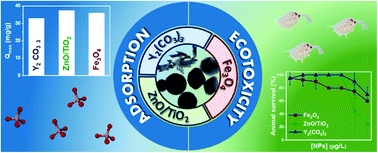Comparative performance and ecotoxicity assessment of Y2(CO3)3, ZnO/TiO2, and Fe3O4 nanoparticles for arsenic removal from water†
Abstract
The application of nanomaterials to remove arsenic from water represents one of the most promising remediation methods nowadays. In this study, three active materials, Y2(CO3)3, ZnO/TiO2, and Fe3O4, with different structural and morphological properties, were evaluated for their As(V) adsorption capacity in contaminated water. Thus, the adsorption behaviour was assessed, including the influence of pH, adsorption kinetics, and isotherms. This work demonstrates that the active materials show a high adsorption performance, with adsorption efficiencies always close to 100%, leading to maximum adsorption capacities of 32.8, 37.3, and 35.8 mg g−1 for Y2(CO3)3, ZnO/TiO2, and Fe3O4, respectively. The effects of suspended sorbent nanomaterials on Daphnia magna allowed us to estimate the lethal concentration that kills 50% of the test specimens (LC50) of 6.57 × 103 mg L−1, 28.7 mg L−1, and 1.91 × 106 mg L−1 for Fe3O4, ZnO/TiO2 and Y2(CO3)3, respectively. Overall, this study confirmed the investigated materials' suitability for arsenic water remediation applications.



 Please wait while we load your content...
Please wait while we load your content...